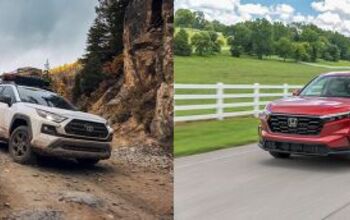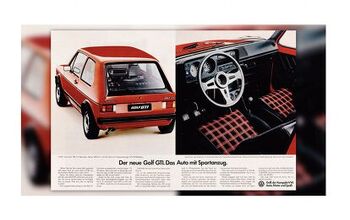Fifty-Four Forty or Fight?
Americans sometimes joke that Canada is the fifty-first state. In some ways, it's true; our landscape is the northern part of the US blown up like Bullwinkle at Macy's parade. The journey from one end of Ontario to the other is roughly equivalent to crossing five US states. If Canadians followed the American rationale– drivers need wafting monster machines to keep their sanity on long treks– there'd be an Escalade in every driveway. Yet Canadian SUV and truck ownership ratios are miniscule compared to that of their southern neighbors. In the main, we opt for more frugal and environmentally-sound transportation. Hang on. There's a lesson in there somewhere…
Canadian car culture– or lack thereof– is one reason our nation doesn't favor inefficient and inappropriate vehicles. We love our cars, but we're not "in love." A Canadian would never write a song like "Route 66;' a paean to the Trans-Canada Highway during a January blizzard would only scare its listeners. Roadside diners are the dens of long-haul truckers, not shrines to the open road celebrated in movies like Thelma and Louise. Don't get me wrong: there are plenty of pistonistas north of the 49th parallel; custom Civics and classic Mustangs abound. But a healthy (if stubborn) kind of pragmatism dominates Canadian car buying. Even sports cars are bought with city potholes and snow in mind.
Canadians also don't accept the idea of car as automotive armor. We're a cold country, but there's no SUV Cold War, where vehicles get larger to protect against larger and larger vehicles. We're too mellow to engage in this automotive arms race. According to the US Department of Transportation, aggressive driving contributes to two-thirds of fatal crashes. Studies show that Americans are several times more likely than Canadians to die in a crash. Do the math. We've got time.
Perhaps most importantly, Canadian car owners have more consumer choice than their southern neighbors. If Canuck drivers want something more than a no-frills supermini, but smaller and more affordable than a boat, options abound. How about a Smart fortwo? Laugh all you like at its golf cart looks, but a Smart is a stylish, comfortable and well-equipped machine whose owner laughs last when his weekly fuel bill costs as much as a fast food combo meal. We had the Yaris long before you, and Toyota didn't have to call it a "liftback" to make it more palatable to smallcarophobics.
Canadians who crave a posh ride can buy a compact as comfortable as your Ford Explorer. Acura, for instance, sells an upscale version of the Honda Civic called the CSX. It's faster than a stock Civic, but the running costs won't make you weep like a fuel-hungry BMW. Mercedes also sells their B-class "sports tourer" (read: upscale hatchback) that delivers C-Class roominess in a smaller, more fuel-efficient package. In all these cases, you can get leather seats, premium audio and navigation without having to crush everyone in your path or sell your soul to the oil demons. In short, you don't have to buy a trendy hybrid to enjoy sensible, environmentally sensitive motoring.
It's true that most of these cars are also available in Europe. However, unlike Europeans, Canadians don't have to buy one because a larger car is scary on a narrow side street or they can't afford the tax-inflated fuel costs. Canadians buy these sensible machines because they do what they want them to do– including delivering enjoyable driving dynamics– without wasting petrochemical resources or space. Why shouldn't Americans be encouraged to think the same way?
Car manufacturers operating in the US claim that the market won't sustain stylish small cars. In truth, it's a classic chicken-and-egg argument. How are Americans supposed to get excited about small cars when their primary purpose is to help manufacturers meet their average fuel consumption targets? The Canadian market tells us that there's another way: give people small, stylish, fun-to-drive cars that they'll actually want to own, and own them they will. The MINI proved the point.
It's time that US consumers realized that having long highways doesn't mean you have to wax poetic about the journey or traverse them in barge-sized cruisers. You can switch to a smaller car without being smashed into a guide rail. You can be practical without losing creature comforts. We Canadians know these facts already. We reap the benefits every time our smaller cars avoid a crash or pamper us with luxury and lower fuel bills. If our friends to the south would only catch up, we'd soon see a more socially responsible mix of vehicles on both sides of the border.
More by Jonathan Fingas
Latest Car Reviews
Read moreLatest Product Reviews
Read moreRecent Comments
- Probert They already have hybrids, but these won't ever be them as they are built on the modular E-GMP skateboard.
- Justin You guys still looking for that sportbak? I just saw one on the Facebook marketplace in Arizona
- 28-Cars-Later I cannot remember what happens now, but there are whiteblocks in this period which develop a "tick" like sound which indicates they are toast (maybe head gasket?). Ten or so years ago I looked at an '03 or '04 S60 (I forget why) and I brought my Volvo indy along to tell me if it was worth my time - it ticked and that's when I learned this. This XC90 is probably worth about $300 as it sits, not kidding, and it will cost you conservatively $2500 for an engine swap (all the ones I see on car-part.com have north of 130K miles starting at $1,100 and that's not including freight to a shop, shop labor, other internals to do such as timing belt while engine out etc).
- 28-Cars-Later Ford reported it lost $132,000 for each of its 10,000 electric vehicles sold in the first quarter of 2024, according to CNN. The sales were down 20 percent from the first quarter of 2023 and would “drag down earnings for the company overall.”The losses include “hundreds of millions being spent on research and development of the next generation of EVs for Ford. Those investments are years away from paying off.” [if they ever are recouped] Ford is the only major carmaker breaking out EV numbers by themselves. But other marques likely suffer similar losses. https://www.zerohedge.com/political/fords-120000-loss-vehicle-shows-california-ev-goals-are-impossible Given these facts, how did Tesla ever produce anything in volume let alone profit?
- AZFelix Let's forego all of this dilly-dallying with autonomous cars and cut right to the chase and the only real solution.





































Comments
Join the conversation